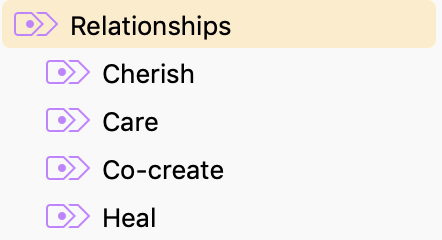This post is inspired by the ongoing thought experiment: What if task management software was designed to help us be our truest selves instead of helping us be as productive as possible? I’ve previously shared two strategies: “Be a Good…” lists and crafting tasks as messages of kindness from past to present self. Today, I would like to share a method for reorganizing projects and tasks to better align with the life we want to live.
Please note: This method applies to any software that invites the user to organize her tasks into projects and folders. I’m using OmniFocus for this, but the process would work in many popular apps. As for handwritten lists, it may be a little less appropriate, but it would work if you are creating collections in the Bullet Journal style.
Areas of Responsibility
A popular method for figuring out task management structure is to map areas of responsibility. In the Getting Things Done methodology, David Allen suggests that you create “a complete inventory of everything you hold important and are committed to.” He goes on to suggest moving down each area and creating “reminders of key areas of responsibility, your staff, your values, and so on.” The lists below are examples from his book about what a complete inventory and drilling down into a key area might look like:
key areas
Career goals:
Team morale
Processes
Timelines
Staff issues
Workload
Communication
Complete Inventory
Career goals
Service
Family
Relationships
Community
Health and energy
Financial resources
Creative expression
These lists can inform how tasks and projects are organized. Given the above example, it is natural to create project folders and contexts that align with those areas. If I follow this advice and create a map of my own areas of responsibility, it looks like this:
Using these areas, I might create a project for my design methods class this summer under teaching, and put the map of restorative space I’m designing under research. My role as an Of/By/For All board member might go under global service. An acupuncture visit could go under health. This framing accommodates pretty much anything I can think to do and much of the software that I’ve explored fits well within it.
Areas of Possibility
Consider, however, what happens when we decide to map areas of possibility instead. Instead of creating an inventory of all the areas of my life, I create areas of possibility by asking myself what life I want to live into. I move from an “inventory” mindset to an inherently creative activity. I must imagine what my life could become. Heres what I get when I map areas of possibility:
These areas reflect a combination of factors that are significant to me right now. Some are heavy on my heart and mind (like good health and spirituality), others are exciting and energizing (like creating a life of writing and teaching), and others are more oriented toward the contemplative (like appreciating the miracle of being in alive still and in the first place). To create this list, I imagined my future self, looked at the quality of her life, and described it with these sentences. It is important to note, however, that those imaginings were informed by a steady observation of my life as it is today and what it reveals about who I am becoming. In other words, mapping areas of possibility is observational, not aspirational.
In Let Your Life Speak, Parker Palmer writes, “Before I can tell my life what I want to do with it, I must listen to my life telling me who I am.” The areas I’ve mapped above were created in that spirit. For example, the area labeled “my everyday working life feels like the general exam” was inspired by reflecting on how right it felt to write eight hours a day everyday for two weeks during my general exam—how wholly satisfied I felt at the end of each day, even the hard ones, and how easy it was to re-engage each morning. Noticing that about myself revealed a possibility to live into a life that may be particularly right for me. The area labeled “I appreciate how precious human life really is” was in response to the contemplative practices I’ve held for years and the chief lesson they’ve taught me, which is, in Mary Oliver’s words, “doesn’t everything die at last, and too soon?” It is inspired by small moments, like when I look across the room at my wife as she does yoga and appreciate that her life is limited and one day I will not be able to do something so casual and fleeting and wish that I could.
In mapping responsibilities, Allen drills down into each area to explore its key features. Doing this in a map of possibilities might look like:
I appreciate how precious human life really is:
I stay present to life as it unfolds.
I appreciate those around me, realizing I will lose them.
My everyday working life feels like the general exam:
I cook all my meals.
I take daily walks or ride on my bike for fun.
I write for hours each day.
I exercise my mind and thoughts to their limit.
I approach answers to big, complex questions.
Considering the two lists above, writing this blog post might fit under a project folder called “The Writing Life,” which would support me in “writing for hours each day.” Preparing for a visit from a friend might fit under a project called “Life is Precious,” which would support me in “appreciating those around me, realizing I will lose them.”
Translating Map Into Structure
For a long time, I organized my tasks into a folder structure that reflected areas of responsibility (left), but now I’m organizing based on areas of possibility (right). The magic of this organizational tweak is that now certain projects feel like they don’t belong and I have to reckon with that, including reconsidering them altogether.
Areas of Responsibility:
Areas of Possibility:
My areas of possibility have become folders in OmniFocus: “I am in good health,” and “I feel at peace with my spirit” have turned into a folder “Healing Happens”; “My everyday working life feels like the general exam,” has turned into “The Writing Life”; “I am in relationship with others as a teacher” has turned into “The Courage to Teach” (a nod to Parker Palmer’s sage advice about teaching); and “I appreciate how precious human life really is,” has led to two folders, “Life is Precious” (present-oriented) and “For and With” (care-oriented). It has also changed the way I organize my tags. For example, my “Agendas” tag used to be full of people organized by area of responsibility. Now I am reminded of how I want to engage with people. For example, Marilyn is now under “Cherish” and Chickens are now under “Care.”
Areas of Responsibility:
Areas of Possibility:
Organizing my folders this way helps OmniFocus serve as an ally in me becoming my truest self. While I’d never put a task, “Look at Marilyn” under a project “Appreciate my Wife” in my folder “Life is Precious” and check it off when it’s done, the structure of my projects now serves as a reminder that the work I do each day, ticking off this box or that box, is my life. By being thoughtful about how I use this technology, I can make the life I want to live available to me right now by changing the content of those boxes.






